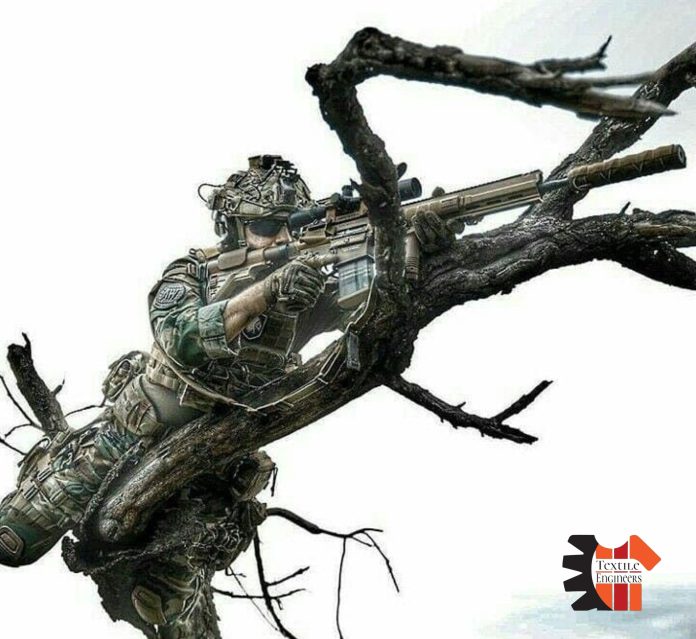WHAT CAMOUFLAGE ACTUALLY IS?:
“God is camouflage.” Fashion designer Claude Sabbah’s statement implies that camouflage, both as a concept and a pattern, is omnipotent and omnipresent. How could a simple textile pattern ever be compared with God? If Sabbah’s opinion is correct, how did camouflage achieve such power?
Characteristics
• Disruptive coloration – Camouflage prints use irregular splotches of color like greens, browns, tans, etc. to help break up the outline of the object and make it blend in with natural backgrounds like forests or deserts.
• Mimicking patterns – Many camouflage fabrics try to mimic the texture and patterns found in nature, like leaves, branches, sand, rocks, etc. This helps disguise the shape and surface of what’s being concealed.
• Diffusing light/shadow – The colors and patterns are designed to diffuse and break up light and shadows, which can give away the form of an object. This makes the object blend into the natural light and shadows of the environment.
• Matte finish – Camouflage fabrics typically have a matte, non-shiny finish to avoid glare that could draw attention. A shiny surface stands out.
• Concealing movement – The camouflage colors and patterns disguise motion and make it harder to pick out movement against a complex background.
So in summary, camouflage allows something to blend into its surroundings by mimicking natural colors, textures, light effects, and patterns to avoid easy detection. These characteristics help camouflage fabrics conceal people, vehicles, equipment, etc. when used effectively.
Current Trend of Camouflage:
• Multi-terrain/transitional camo – Patterns like Multi-Cam and Scorpion W2 are popular for blending into multiple environments. These feature muted shades that work in many areas.
• Digital camo variations – Digital camos like MARPAT and pixelated patterns continue to evolve with new colorways and arrangements optimized for different regions.
• Biomimicry camouflage – Some new patterns mimic animal or insect camouflage found in nature, like reptile scales or zebra stripes. This makes use of time-tested natural camouflage.
• Fractal and algorithmic patterns – Mathematically generated camo based on fractals, chaos theory, and algorithms create highly abstract, asymmetric designs.
• Urban camo – Shades of grey, tan, black, and white have emerged for concealing soldiers and equipment in urban settings. Some mimic concrete, asphalt, and shadows.
• Accessorizing camo – Camo is expanding beyond combat uniforms into accessories like backpacks, hats, and boots to allow head-to-toe concealment. Even vehicle and firearm camo is growing.
• Camo-inspired fashion – Camouflage style is influencing mainstream fashion with camo-patterned jackets, pants, and accessories incorporated into casual wear.
• Advancements in printing – Digital printing and dye-sublimation allow for incredibly precise camo patterns at high resolution translated onto fabric.
• Smart camouflage R&D – Hi-tech camouflage with sensors, adaptive materials, and active camouflage continues to advance, potentially yielding dynamic camouflage
CONCLUSION
The principles of camouflage are growing at a fast rate and increasing day by day. The main users of camouflage fabrics are hunters, including game watchers, and the military. Most of the studies focus on the positive aspects of camouflage in the defense sector. But at the same time, if the enemy uses camouflage fabric, it might become difficult for us to spot the enemy. The camouflage fabric creates an illusion for the observer and as a result, the camouflaged object becomes blurred or unrecognizable. Furthermore, the cost of the camouflage fabric is higher than the normal grade fabric but if the production of camouflage fabric increases then the cost might decrease. The principles of camouflage are also used for decoration purposes which results in value addition.
Reference:
- www.google.com
- www.businessinsider.com
- https://textilevaluechain.in/
- FROM COMBAT TO COUTURE: CAMOUFLAGE IN FASHION by Sarah Scaturro
- Camouflage Fabric – Fabric for Today’s Competitive Era by Madan Lal Regar, Akhtarul Islam Amjad, Atiki Singhal
Writter:
Md. Nabil Hassan
General member of TES (NITER)


